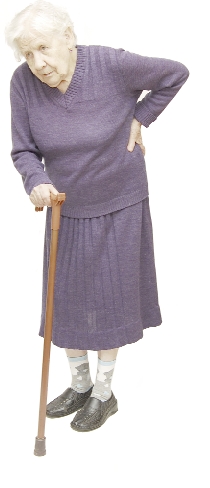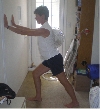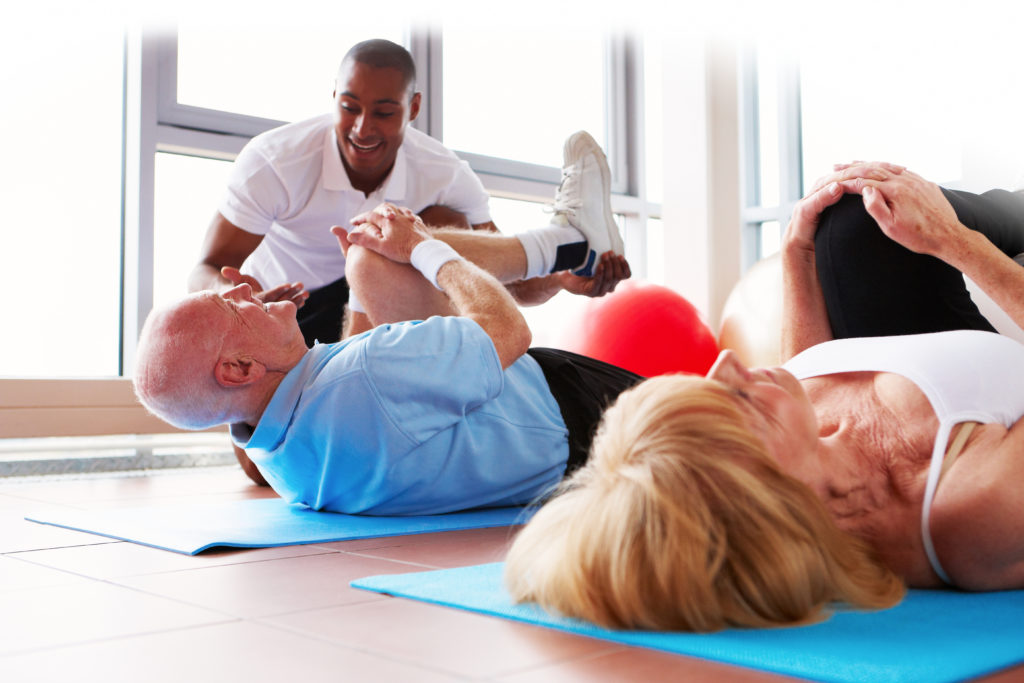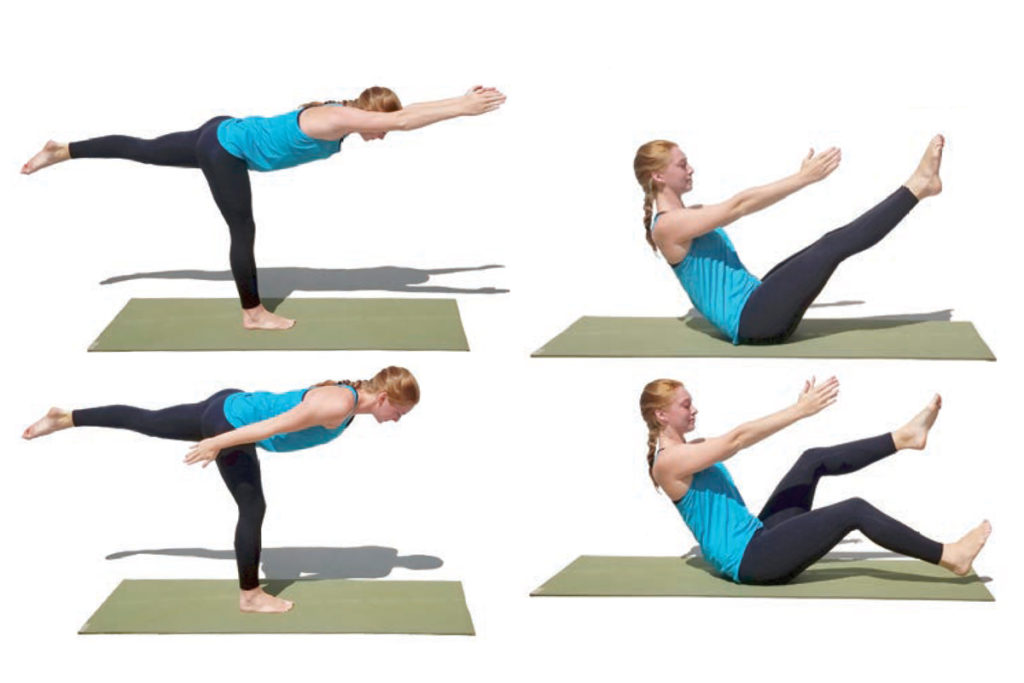Repositioning Poor Posture
There are reasons and ways to help older clients correct improper posture.
| Earn 1 CEC - Take Quiz
Earn 1 CEC - Take Quiz

Poor posture is prevalent in older adults. As we age, it is common for the head to move forward and the shoulders to round, which can cause chronic back and neck pain. Our once swift and sure stride is replaced with a sort of shuffle (Griegel-Morris et al. 1992). Sadly, this kyphotic posture (characterized by extreme convex curvature of the upper spine) can increase the risk of falling. Often, individuals who develop these physical characteristics must rely on a cane or walker to ambulate.
Years of inattention to how the head and shoulders are positioned can lead to tight pectoral muscles and weak upper-back and neck muscles, which can result in postural kyphosis. At the same time, the Achilles tendons and hamstrings become tight, and the feet begin to shuffle and scuff the ground while walking, which can lead to a higher risk of falls. This “senior shuffle” is unsafe. As the forward-tilting shoulders shift the center of balance frontward, older people become less steady on their feet and have a greater tendency to fall. Unless they suffer from advanced osteoporosis, this unattractive way of standing or sitting is a learned behavior. Fortunately, fitness professionals can help to set straight what has become crooked! By incorporating several stretches and strengthening exercises into your clients’ routines and instructing clients on proper posture, you decrease their risk for debilitating pain and for nonfatal or fatal injuries resulting from falls.
Incidence of Serious Falls Growing
According to the U.S. Census Bureau (2010), nearly 39 million Americans were 65 years or older in 2008. That total represents 13% of the U.S. population. By 2050 this group is expected to reach the 20% mark. With progressing age comes increased sarcopenia (age-related loss of skeletal muscle), impaired balance and decreased range of motion. Add poor posture and shuffling feet to that list, and the risk for falling escalates. Statistics compiled by the Centers for Disease Control and Prevention (2009) show that more than one-third of adults aged 65 and older fall each year in the United States.
Poor Posture and Its Effect on Breathing
Di Bari (2004) documented that kyphosis is associated with dyspnea (discomfort or difficulty breathing, shortness of breath) and ventilatory dysfunction (abnormal breathing or oxygenation of the blood), as measured by pulmonary-function test data.
“A head that is positioned forward and shoulders that are rounded decrease the space in the chest cavity and restrict lung function,” says Debra Jensen, PTA, e-RYT, CHC, of Southampton, New York, who provides physical therapy and yoga for individuals with cervical kyphosis and a shuffling gait. She adds, “Persons with poor posture may be unable to breathe deeply, resulting in shallow breathing. Continued shallow breathing can cause general fatigue and shortness of breath.”
Posture, Gait and Chronic Disease
Individuals who suffer from chronic disease have an increased risk of developing posture and gait abnormalities. Research has found a strong correlation between severe chronic obstructive pulmonary disease (COPD) and walking abnormalities, concluding that severe COPD causes compromised gait (Yentes et al. 2010). People who have had coronary artery bypass surgery often assume a hunched-over posture to protect the roughly 6-inch-long surgery incision carved into their chests. Similarly, people who suffer from chronic conditions that require prescription medication are at an increased risk of tripping or falling (Lipsitz et al. 1991).
Interestingly, research finds no relationship between flexed posture (of which kyphosis and a forward head are measures) and osteoporosis. Balzini et al. (2003) found that the severity of flexed posture in elderly female patients (without apparent co-morbid conditions) was directly related to the severity of vertebral pain, emotional status, muscular impairments and motor function, but not to osteoporosis.
Vertebral Disks
In a healthy spine, the vertebrae are aligned almost perfectly parallel to one another and are arranged to maintain the shock-absorbing natural curves of the spine. The vertebrae do not constrict the disks in any way. In a spine that must hold the head in a forward position, the tilted, compromised vertebrae crush the fragile disks and compress nearby nerves. When the head is repositioned, the vertebrae can resume their alignment. Disk pressure is relieved, and nerves are decompressed, thus relieving pain and discomfort.
Jolie Bookspan, MEd, PhD, FAWM, is a sports medicine scientist, director of Neck and Back Pain Sports Medicine, an instructor at Temple University, Philadelphia, and author of Fix Your Own Pain without Drugs or Surgery (Healthy Learning 2006). On her website (www.drbookspan.com), she writes, “The pressure of your own body weight on your neck muscles and discs over years of poor sitting, standing, and bending habits is enough to injure your neck as badly as a single accident. After years of squashing the discs in your neck with a forward head posture—by letting your head drop forward, or jutting your chin forward, the discs in your neck may herniate and press on nerves, sending pain down your arm. Tight muscles from years of poor positioning and short resting muscle length can also press on the same nerves, mimicking nerve impingement pain.” She concludes that “a degenerating disc is not a disease, but a simple, mechanical injury that can heal, if you just stop grinding it and physically pushing it out of place with unhealthy habits.”
Posture Assessment: Top to Bottom
To quickly assess posture, have your client slowly walk backward into a wall. The head, upper back and buttocks should all touch the wall. If they don’t, your client may need some adjusting.
Staying within your scope of practice, begin your assessment at the head to ascertain if the ear lobes rest over the clavicles. Tight pectorals and weak upper-back muscles can cause the chin to jut forward and the ears to reposition themselves forward of the shoulders, leading to further damage to the upper spine. The chin should be pulled in, with the client looking straight ahead, not up. The shoulders should be back and not rounded.
Next, check for proper gait. Have your client walk forward several feet while you observe from the side. The heel of the stepping (front) foot should strike the ground first, and forward momentum should shift the weight to the ball and toes of that foot, pushing off the ground. If the ankles do not flex, allowing the heels to strike the ground before the balls of the feet, your client probably has tight Achilles tendons and calf muscles and weak anterior tibialis muscles. Short strides in conjunction with a flat-footed gait likely indicate that the gluteal muscles, hip flexors and hamstrings are tight, while the quadriceps muscles are weak.
Awareness
Remind clients that posture awareness is paramount when it comes to straightening up. All the stretches and strengthening exercises in the world, even with proper form, won’t lead to improved posture if new habits don’t replace old, bad ones. Give your clients these encouraging reminders—all helpful in promoting healthy cervical posture:
- Always sit and stand tall.
- Let the rhomboids pull the shoulders back and together.
- Hold the chin above the chest.
- Check that the ankles are dorsiflexing and plantar flexing during walking, with the heel of one foot striking the floor as the ball of the other pushes off.
Like many chronic health-related conditions, poor posture combined with a shuffling gait can be prevented by making small adjustments to unhealthful habits. Health professionals are in an excellent position to work with clients to both prevent and reverse these problems. See the sidebar “Postural Sketches and Stregtheners” for specific guidelines.
Incorporate these stretches and strengthening movements for better posture and gait. Hold each stretch posture for 30 seconds. Breathe deeply as you hold the pose.
Stretches

The “W” Stretch (for upper back and neck). Back is against a wall; knees are bent slightly. Step about 12 inches away from wall with both feet. Contract abdominals with shoulders, back and buttocks against wall. Without lifting chin, try to touch back of head against wall. For some this will be difficult; bring head back as far as possible and improvements will occur. Bring arms up to make the letter W. Bend elbows at shoulder height, wrists above elbows and palms facing forward. Keeping body against wall, draw arms back until elbows, wrists and hands touch wall. Tight pectoral and deltoid muscles may prevent elbows from touching wall.

Pectoral Stretch. Stand approximately 12 inches from wall. Face wall and lift right elbow to side, wrist above elbow, palm facing frontward. Turn slowly to left, allowing elbow and forearm to come into contact with wall. Continue to turn to left until you feel slight stretch in right pectoral muscles. Repeat with left arm.

Trapezius Stretch. Stand tall and cross right hand behind you as if putting that hand in left back pocket. Slowly bend to left side, bringing left ear toward left shoulder. Do not lean forward. Repeat with left hand.

Standing Hip and Thigh Stretch. Do this exercise only if you can support yourself properly and adequately balance. Hold onto wall or backrest of chair. Bend right knee, and grasp right foot with right hand. Back shouldn’t arch. Knees should be side by side. Repeat with left leg.

Standing Hamstring Stretch. Place right heel on low step so leg is almost straight. Supporting left leg should be slightly bent at knee. Slowly lean forward until you feel slight pull in back of right thigh. Repeat with left leg.

Standing Calf and Achilles Tendon Stretch. Stand with hands on wall or other stable object. Keeping right leg straight with heel flat on ground, step forward approximately 24–30 inches with left foot, then lean forward, bending left knee. Repeat with other leg.
Strengtheners
Neck. While seated in car or in chair with headrest, press hips back in seat and lean back slightly, pressing back of head gently against neck support. Hold for 5 seconds. Repeat 8-15 times.
One-Arm Row; Seated Row; Double-Arm Row; Lat Pull-Down; Reverse Flye; Weighted Shrugs. These exercises strengthen upper- and middle-back muscles (trapezius, rhomboids, latissimus dorsi, rear deltoid) that have become weak and stretched. This will help properly reposition shoulders that have been rotated forward.
Dorsiflexion; Ankle Eversion; Ankle Inversion. Use elastic resistance band to increase strength of anterior tibialis.
Gluteals. Lie supine with knees bent at 10- to 15-degree angle. Squeeze buttock muscles. Hold for 5 seconds. Repeat 8-15 times.
References
Centers for Disease Control and Prevention. Falls among older adults: An overview. www.cdc.gov/homeandrecreationalsafety/falls/adultfalls.html; retrieved July 13, 2010.
Di Bari, M. 2004. Thoracic kyphosis and ventilatory dysfunction in unselected older persons: An epidemiological study in Dicomano, Italy. Journal of the American Geriatrics Society, 52 (6), 909–15.
Griegel-Morris, P., et al. 1992. Incidence of common postural abnormalities in the cervical, shoulder, and thoracic regions and their association with pain in two age groups of healthy subjects. Physical Therapy, 72 (6), 425–31.
Lipsitz, L.A., et al. 1991. Causes and correlates of recurrent falls in ambulatory frail elderly. Journal of Gerontology, 46 (4), M114–22.
U.S. Census Bureau News. 2010. Facts for Features (Mar. 2). www.census.gov/newsroom/releases/pdf/cb10-ff06.pdf; retrieved July 13, 2010.
Yentes, J.M., et al. 2010. Walking abnormalities are associated with COPD: An investigation of the NHANES III dataset. Respiratory Medicine. www.resmedjournal.com/article/50954-6111(10)00286-6/abstract; retrieved Sept. 8, 2010.





